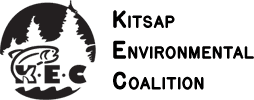COMMENTS FROM THE KEC WORKING COMMITTEE ON THE PROPOSED CAO – continued
5. BOUNDARY MARKING AND MEMORIALIZATION
For critical area or buffer boundaries to be honored in the future they must be memorialized for future owners and residents. Current code lacks such provisions and transgression of boundaries is not uncommon. It is too tempting and easy for a current owner to extend a garden or yard by importing fill. The current requirement allowing wood posts, even if treated, is only a short-term solution. Without a legal recording of the boundary, knowledge of the boundary will disappear with transfer of ownership. Permanent protection of boundaries requires two items.
First, a boundary must be physically identified with non-degradable and locatable markers, as well as temporary signs or wood markers. A driven 1” pipe, as used by surveyors, would be suitable for locating a boundary line, as well as holding a relatively temporary wand with signage.
Second, the boundary line and buffer limitations must be memorialized with a Notice to Title or equivalent legal instrument, which a new owner would necessarily be informed of.
Several places in the code refer in different ways to notice to title, encumbrance, covenant etc. The code would be cleaner with a single definition of a legal encumbrance, and have subsequent code sections reference that definition.
We acknowledge that legal protection, per Ecology Consistency & Gap Analysis Recommendation #10, is a proposed requirement for compensatory mitigation with buffers 19.700.715.B.12.
6. SETBACKS
In the current Title 19 code, a minimum construction setback of 15’ is required. Generally, 15’ is an absolute minimum for practical site use and building maintenance. Less space guarantees transgression of a boundary by mowing, fill, and other activities in order to improve utility of the property.
The code 19.200.220.E currently allows “minor structural or impervious surface intrusions” with a determination of no adverse impact. However, in practice the department has allowed a continuous decrease in the setback and does so without any determination. This practice should be prohibited.
Recommendations.
Insert a definition for setback as follows:
“19.150.567. For the purposes of Title 19, “setback” is an area measured from a buffer boundary within which a structure or impervious surface is prohibited. The position of a structure shall be measured to the nearest wall or vertical element.”
Revise 19.200.220.E.
“A structure or impervious surface setback of not less than fifteen feet is required from the edge of a wetland buffer, including exempt wetlands in 19.200.210.C. The fifteen-foot setback is considered a minimum for practical use and maintenance and may not be decreased.”
Revise 19.300.315.A.7.
“A structure or impervious surface setback of not less than fifteen feet is required from the edge of a fish and wildlife habitat conservation area buffer. The fifteen-foot setback is considered a minimum for practical use and maintenance and may not be decreased. The setback shall be identified on a site plan.”
Revise 19.300.315A.2 by deletion of “…and building setbacks…” in ¶2.

